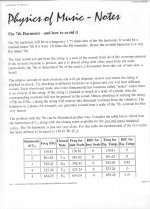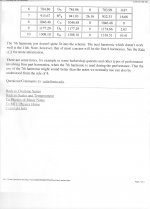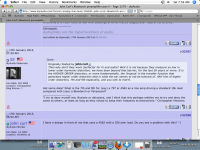SACD's or better, for me. '-)
Jan, just got Vol. 3, thanks.
Good! I am all for 'education permanente' as the French say
jan
Gentlemen please remember that the measurements shown by JC are made by Samuel Groner / Weiss.
For those interested that haven't seen the measurements, go to Samuel's homepage and download the (op_amp distortion.pdf), (too large to attach)
IMHO Samuel is trying as much as possible to kill all IC OpAmps, why?
Remember that he is working for WEISS and that they have a their own solution. Their own discrete OpAmp.
Think about it.
Stein
Stein, funny you say this. If you are so concerned about conflict of interest, you should start to delete ALL posts in this forum by people who are in the industry. Sorry JC, sorry Scott, Richard, bear - you all have double agenda's can't have that, all your posts pooof...
jan
Give up guys.... you've tried for months and years to get JC to compare distortion numbers and means and methods... he isnt going to do it. IMO comparing thd and noise and bandwidth becomes a numbers game for marketing. JC has said he belivevs there is more to better audio performance than only those numbers.
The problem is that John explicitly said that competitive preamps using IC opamps were "mid-fi" because of higher 7th and 9th harmonic levels compared to the equipment that his "team" designs. That is an objective, numbers-based claim.
Maybe it's just me and my silly stiff-necked sense of honesty, but if I claimed a performance shortfall for products which competed with mine, I'd have data to back it up or be willing to retract my claim. The fashion audio world is apparently different...
For everyone to more completely understand:
Analog magnetic tape IDEALLY doubles in distortion for every 3dB rise in level. Of course, it decreases in the same amount for every 3dB fall in level.
This follows the mathematical law of generating 3'rd harmonic distortion.
So: 6dB rise gives 4 times more, 10dB rise gives 10 times more.
With high speed tape, it is VERY consistent with this prediction.
That's fine, but what evidence do you have that this is applicable to preamps?
If arguendo we use your calculational method to look at a 797 in the distortion magnification mode used by SG (which is unreasonable), for the same signal levels you asserted for the BT (which I agree are reasonable and are 20dB below SG's level), and a 600R load (which is unreasonable), the 7th harmonic would be at (-113dB - 6{20dB}) = -233dB. I think even Ed would strain at that one.
Your assertion continues to ring false.
T
If arguendo we use your calculational method to look at a 797 in the distortion magnification mode used by SG (which is unreasonable), for the same signal levels you asserted for the BT (which I agree are reasonable and are 20dB below SG's level), and a 600R load (which is unreasonable), the 7th harmonic would be at (-113dB - 6{20dB}) = -233dB. I think even Ed would strain at that one.
Even if it was only -500dB, the 7th is an Evil!!
Almost true, John. However, it is not enough to be below clipping - you also need to be below the level where, say, 7th order nonlinearity contributes significantly to 3rd order distortion. Therefore you need a set of measurements at different signal levels which demonstrate that this is true. Provided your set of measurements roughly follow the power law you describe, then you can fairly reliably extrapolate downwards.john curl said:First of all: ANY open loop system that is also Class A has a predictable distortion curve, ONCE you get an accurate set of measurements at some typical level. You can go both up or down in level and PREDICT the distortion with a great degree of accuracy.
Come on everybody, look it up in a textbook on non-linear circuit analysis.
Let me give an example of how I would (and do) estimate distortion in an open loop, Class A system:
First, I get a set of exact measurements of each harmonic at some part of the operating level within the design parameters of the design, i.e. NO pre-clipping levels, as this will throw off the estimate.
Then: For 2'nd harmonic, estimate that its value drops directly with voltage level.
For 3'rd harmonic, estimate that its value drops directly with the SQUARE of the voltage level.
For 4'th harmonic, estimate that it drops to the CUBE of the voltage level.
Etc, etc.
Now what about 7th harmonic? It should drop as the 6th power, which implies that if you drop the voltage level in 1/2, then the 7th harmonic should drop by a factor of 64.
There also has to be an assumption that there are no low-level effects in contacts etc. No point in having Class A devices with Class B wiring! Except under fault conditions I doubt that such things are a problem, but some people worry about them.
Even if it was only -500dB, the 7th is an Evil!!
For some its the 7th, for others its Class D amps. Everyone has his phobias I guess.
...usually defined as a persistent fear of an object or situation in which the sufferer commits to great lengths in avoiding, typically disproportional to the actual danger posed, often being recognized as irrational.
Phobia - Wikipedia, the free encyclopedia
Last edited:
I am VERY surprised to read that under your pen John. When we arrive near the saturation of the tape, the response curve begin to change. ~0dB is the max level you can achieve at 10hHz and 15 Ips, right ? While you have more than 10dB more available under. So the harmonic distortion is not linear at all, and the higher harmonics decrease, there, where the level increase.I was exposed to it for many years with analog tape recording, in which the 3'rd harmonic (totally dominant because of the tape itself) could be reliably predicted, over and over, with different recording levels, once a single distortion with level was measured.
It explain the "hot" sound with tape on hight transients.
I used sometimes, to clip the kick drum, and record-it that way on tape at VERY high level: Tape's saturation removed all the high harmonics, and gave a very natural 'kick' attack, even when the original sound was dull and just resonant with not enough transient. You were not able to hear distortion, just what you believe is the hit of the beater on the skin, while the sound from the desk was awfully saturated.
Reason why 15 Ips was chosen as the standart professional speed for tape recording.Very little between 15 and 30 ips ....
Last edited:
Because dominant 7th chord was named "diabolus in musica" ?Even if it was only -500dB, the 7th is an Evil!!
OK, I am going to have to 'pull rank' Esperado.
I actually DESIGN analog tape recorder electronics, and I have the experience.
To see this effect easily, you HAVE to measure the 3rd harmonic with some sort of analyzer, the clearest in this case being a WAVE-ANALYZER, as you can tune to just the 3rd, as you go up and down in level measuring a tape as it is being recorded and reproduced. You will find that my assumption is very accurate up to about 10dB above Ampex operating level of 185nW/m or 0 Vu on many machines, including my own, to about 30 dB below 0Vu. This is the range that we normally record material with analog tape.
Many here have never used or worked with a really fast, clean recorder, so your results may vary. For example, lower speeds require a SIGNIFICANT amount of treble boost to make up for tape thickness losses, to the point of extra distortion added at virtually all mid and high frequencies.
Of course the tape SATURATES, and this brings out 5th and even 7th harmonic distortion, at levels above 20dB above 0 Vu as set above, but I found, early on, that it is usually the tape recorder electronics that contributes most of it, due to sloppy design. More headroom was necessary, and I put in at least 6dB more headroom in my own tape recorder electronics, so that tape limiting would be lower order as much as possible.
I actually DESIGN analog tape recorder electronics, and I have the experience.
To see this effect easily, you HAVE to measure the 3rd harmonic with some sort of analyzer, the clearest in this case being a WAVE-ANALYZER, as you can tune to just the 3rd, as you go up and down in level measuring a tape as it is being recorded and reproduced. You will find that my assumption is very accurate up to about 10dB above Ampex operating level of 185nW/m or 0 Vu on many machines, including my own, to about 30 dB below 0Vu. This is the range that we normally record material with analog tape.
Many here have never used or worked with a really fast, clean recorder, so your results may vary. For example, lower speeds require a SIGNIFICANT amount of treble boost to make up for tape thickness losses, to the point of extra distortion added at virtually all mid and high frequencies.
Of course the tape SATURATES, and this brings out 5th and even 7th harmonic distortion, at levels above 20dB above 0 Vu as set above, but I found, early on, that it is usually the tape recorder electronics that contributes most of it, due to sloppy design. More headroom was necessary, and I put in at least 6dB more headroom in my own tape recorder electronics, so that tape limiting would be lower order as much as possible.
First, let's address 7th harmonic. Here is a small article on the subject. I didn't invent the problem, just noted it. It took me less than 5 minutes to find it with 'Google'.
You're barking up the wrong tree John. Nobody disputes that 7th sound bad.
What is disputed is that you seem to be able to hear it at -10zilliondB even from 5 miles out
jan
Is this one (one of my favorites) have your finger's traces ?
http://www.historyofrecording.com/images/Ampex_MM1100_16.jpg
I used all kind of professional mutlitrack tape recorders, Scully, Ampex and Studer.
My personal mastering machine was an Ampex ATR100. Clean enough ?
http://www.historyofrecording.com/images/Ampex_MM1100_16.jpg
I used all kind of professional mutlitrack tape recorders, Scully, Ampex and Studer.
My personal mastering machine was an Ampex ATR100. Clean enough ?
OK, time for clarification: 7th harmonic is one of the most significant harmonics that the ear can detect with music. It is fairly easy to generate, as well, with crossover distortion and diode nonlinearities in electronic circuitry.
A dozen years ago, my main assumption was that if I could reduce 7th harmonic at listening levels to, let's say: -120dB or one part in 1 million, then the circuitry should be OK. I used this standard to compare my Parasound power amps, testing them invariably at the Xover region between Class A and Class A-B, where the transfer function is the weakest. This is NOT a classical Class A situation, and like IC's, can suffer Xover distortion, of some magnitude, during the transition between Class A and Class B.
Now, this transition may happen between 1W and 30W on my power amps, but where does it come in from a typical IC?
Let us use the approximation that the output stage is biased at 1/2ma. That means that the A-B transition will happen after about 1ma peak output, either + or - .
What voltage level does that translate to?
Well if we did what SY directs, then we would have a 10K feedback resistor with a 1.1K to ground, and a 50K amplifier load. This would be an effective load of about 10K, so 1ma and 10K load, gives us 10V peak output. Pretty good, but is it practical? No, because in the case of the AD797, the noise has risen 5 times over the design's inherent capability, due to the 1K of feedback resistance of 4nV/rt Hz. So, IF you want to use the capability of the AD797 to its advantage, we MUST reduce the feedback resistor. I recommend 50 ohms, that only throws away about 3dB from the best noise possible. Now for a gain of 10, what is the main feedback resistor value? It is 450 ohms, giving the op amp a 500 ohm load. Too much? What to do? How about 1500 ohms for the output, and 165 ohms for the feedback resistor? Not bad, BUT you could not get any more than 1.6V PEAK from the IC, before it went into Class A-B transition. Now, is that a problem? To me, yes, to you, perhaps not.
A dozen years ago, my main assumption was that if I could reduce 7th harmonic at listening levels to, let's say: -120dB or one part in 1 million, then the circuitry should be OK. I used this standard to compare my Parasound power amps, testing them invariably at the Xover region between Class A and Class A-B, where the transfer function is the weakest. This is NOT a classical Class A situation, and like IC's, can suffer Xover distortion, of some magnitude, during the transition between Class A and Class B.
Now, this transition may happen between 1W and 30W on my power amps, but where does it come in from a typical IC?
Let us use the approximation that the output stage is biased at 1/2ma. That means that the A-B transition will happen after about 1ma peak output, either + or - .
What voltage level does that translate to?
Well if we did what SY directs, then we would have a 10K feedback resistor with a 1.1K to ground, and a 50K amplifier load. This would be an effective load of about 10K, so 1ma and 10K load, gives us 10V peak output. Pretty good, but is it practical? No, because in the case of the AD797, the noise has risen 5 times over the design's inherent capability, due to the 1K of feedback resistance of 4nV/rt Hz. So, IF you want to use the capability of the AD797 to its advantage, we MUST reduce the feedback resistor. I recommend 50 ohms, that only throws away about 3dB from the best noise possible. Now for a gain of 10, what is the main feedback resistor value? It is 450 ohms, giving the op amp a 500 ohm load. Too much? What to do? How about 1500 ohms for the output, and 165 ohms for the feedback resistor? Not bad, BUT you could not get any more than 1.6V PEAK from the IC, before it went into Class A-B transition. Now, is that a problem? To me, yes, to you, perhaps not.
Well if we did what SY directs, then we would have a 10K feedback resistor with a 1.1K to ground, and a 50K amplifier load.
I must be getting senile because I don't remember citing particular values of feedback resistors. You couldn't possibly be making that up, could you?
So... what about that mid-fi 7th and 9th which separates IC based preamps from true "high end"? Got the data yet or was that also made up?
I mean exactly what I wrote. The vast majority of power amps (yours included) have input impedances of 10k or higher- not 350 or 600 ohms. Configure a good IC as a line stage, drive to the same voltage levels you cited for the BT into a 10k load, and what's the 7th and 9th? For the appropriate choice of feedback components (for argument's sake, choose the same gain as the BT line stage), what's the S/N referenced to the drive voltages you used to illustrate the BT? How does that compare to the S/N for the BT? (Hint: using your asserted power law, I already showed that a 797 will have 7th and 9th at better than -200dB even with a 600 ohm load and configured in a distortion multiplier circuit)
Got that 7th and 9th harmonic data yet?
Got that 7th and 9th harmonic data yet?
The Blowtorch is an open loop transconductance amplifier with a BUILT IN 1K LOAD in each leg. Therefore, an external 10K load is a 'piece of cake'.
NOT TRUE with IC amps, because an effective 10K load is almost impossible to create, except as I showed in my example. What VALUE feedback resistors would you recommend SY?
NOT TRUE with IC amps, because an effective 10K load is almost impossible to create, except as I showed in my example. What VALUE feedback resistors would you recommend SY?
What gain do you want? That is kinda important.  Whatever it is, the datasheet recommendations are a good start.
Whatever it is, the datasheet recommendations are a good start.
Your issue is apparently not reading what I wrote- 10k load is for the IC configured in a line stage, not the bare IC. Skipping words is easy to do when your eyesight starts giving out, something with which I'm painfully familiar at my age.
Your issue is apparently not reading what I wrote- 10k load is for the IC configured in a line stage, not the bare IC. Skipping words is easy to do when your eyesight starts giving out, something with which I'm painfully familiar at my age.
- Status
- Not open for further replies.
- Home
- Member Areas
- The Lounge
- John Curl's Blowtorch preamplifier part II


